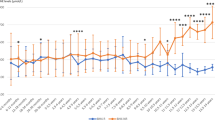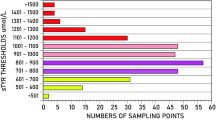Abstract
Objective: Treatment of phenylketonuria (PKU) patients consists of a phenylalanine-restricted diet supplemented with a tyrosine-, vitamin- and oligoelement-enriched amino-acid mixture. Vitamins and oligoelements may be deficient when compliance with the supplemented special formula is poor. Plasma thiol concentrations (especially homocysteine) depend mainly on B-vitamin intake. Our aim was to evaluate the plasma thiol concentrations (homocysteine, cysteine and glutathione) and their determinants (methionine, cobalamin and folate) in PKU patients under dietary treatment compared with age-matched controls.
Design and setting: Cross-sectional study performed in a tertiary care Hospital.
Subjects: PKU (42) patients under dietary treatment compared with 42 age-matched controls.
Interventions: Plasma total homocysteine, cysteine and glutathione were analyzed by HPLC with fluorescence detection. Plasma phenylalanine and methionine were analyzed by ion exchange chromatography. Serum folate and cobalamin were analyzed by radioimmunoassay procedures.
Results: Total homocysteine concentrations were significantly lower in the PKU patients compared with the control group (Students t-test; P<0.0001). Serum folate and cobalamin were significantly higher in the PKU group (t-Student; P<0.0001) compared with controls. A significantly negative correlation was observed between total homocysteine and folate (r=−0.378; P=0.016), and between cobalamin and phenylalanine concentrations (r=−0.367; P=0.022) in the PKU group.
Conclusions: Plasma total homocysteine values are lower in the PKU group than in the controls, probably because of high folate values. High phenylalanine values, an indicator of poor dietary compliance, are negatively associated with cobalamin, which might be deficient in some cases.
Sponsorship: This work was supported by Grants FIS: 00/1056 and Marató TV3: 99/3710. C Colomé was the recipient of a grant from the Hospital Sant Joan de Déu to perform this study.
This is a preview of subscription content, access via your institution
Access options
Subscribe to this journal
Receive 12 print issues and online access
$259.00 per year
only $21.58 per issue
Buy this article
- Purchase on Springer Link
- Instant access to full article PDF
Prices may be subject to local taxes which are calculated during checkout

Similar content being viewed by others
References
Acosta PB & Yannicelli S (1999): Plasma micronutrient concentrations in infants undergoing for pheylketonuria. Biol. Trace Elem. Res. 67, 75–84.
Artuch R, Vilaseca MA, Moreno J, Lambruschini N, Cambra FJ & Campistol J (1999): Decreased serum ubiquinone-10 concentration in phenylketonuria. Am. J. Clin. Nutr. 70, 892–895.
Brenton DP & Pietz J (2000): Adult care in phenylketonuria and hyperphenylalaninemia: the relevance of neurological abnormalities. Eur. J. Pediatr. 159(Suppl 2), S114–S120.
Clarke R, Daly L, Robinson K, Naughten E, Cahalane S, Fowler B & Graham I (1991): Hyperhomocysteinemia: an independent risk factor for vascular disease. N. Engl. J. Med. 324, 1149–1155.
Colome C, Sierra C & Vilaseca MA (2000): Errores congénitos del metabolismo: causa de estrés oxidativo? Med. Clin. (Barc). 115, 111–117.
Colomé C, Artuch R, Vilaseca MA, Sierra C, Brandi N, Cambra FJ, Lambruschini N & Campistol J (2002): Ubiquinone-10 content in lymphocytes of phenylketonuric patients. Clin. Biochem. 35, 81–84.
Darling G, Mathias P, O'Regan M & Naughten E (1992): Serum selenium levels in individuals on PKU diets. J. Inherit. Metab. Dis. 15, 769–773.
El-Khairy L, Ueland, PM, Refsum H, Graham MI & Vollset SE, European Concerted Action Project (2001): Plasma total cysteine as a risk factor for vascular disease: The European Concerted Action Project. Circulation 103, 2544–2549.
Guttormsen AB, Ueland PM, Nesthus I, Nygard O, Schneede J, Vollset SE & Refsum H (1996): Determinants and vitamin responsiveness of intermediate hyperhomocysteinemia (> or =40 micromol/liter). The Hordaland Homocysteine Study. J. Clin. Invest. 98, 2174–2183.
Hanley WB, Feigenbaum AS, Clarke JT, Schoonheyt WE & Austin V (1996): Vitamin B12 deficiency in adolescents and young adults with phenylketonuria. Eur. J. Pediatr. 155, S145–S147.
Loscalzo J (1996): The oxidant stress of hyperhomocysteinemia. J. Clin. Invest. 98, 5–7.
Robinson M, White FJ, Cleary MA, Wraith E, Lam WK & Walter JH (2000): Increased risk of vitamin B12 deficiency in patients with phenylketonuria on an unrestricted or relaxed diet. J. Pediatr. 136, 545–547.
Roediger WEW (1995): New views on the pathogenesis of Kwashiorkor: methionine and other amino acids. J. Pediatr. Gastroenterol. Nutr. 21, 130–136.
Rosenblatt DS & Fenton WA (2001): Inherited disorders of folate and cobalamin transport and metabolism. In The Metabolic and Molecular Bases of Inherited Disease, 8th Edition, eds CR Scriver, AL Beaudet, WS Sly & WS D Valle, pp 3897–3933. New York: McGraw-Hill.
Schneede J, Refsum H & Ueland PM (2000): Biological and environmental determinants of plasma homocysteine. Semin. Thromb. Hemost. 26, 263–279.
Scriver CR Kaufman, Eisensmith RC & Woo SLC (1995): The hyperphenylalaninemias. In The Metabolic and Molecular Basis of Inherited Disease, 7th Edition, eds CR Scriver, AL Beaudet, WS Sly, & D Valle, pp 1015–1075. New York: McGraw Hill.
Sierra C, Vilaseca MA, Moyano D, Brandi N, Campistol J, Lambruschini N, Cambra FJ, Deulofeu R & Mira A (1998): Antioxidant status in hyperphenylalaninemia. Clin. Chim. Acta 276, 1–9.
Siri PW, Verhoef P & Kok FJ (1998): Vitamins B6, B12 and folate: association with plasma total homocysteine and risk of coronary atherosclerosis. J. Am. Coll. Nutr. 17, 435–441.
Van Bakel MM, Printzen G, Wermuth B & Wiesmann UN (2000): Antioxidant and thyroid hormone status in selenium-deficient phenylketonuric and hyperphenylalaninemic patients. Am. J. Clin. Nutr. 72, 976–981.
Vilaseca MA, Moyano D, Ferrer I & Artuch R (1997): Total homocysteine in pediatric patients. Clin. Chem. 43, 690–692.
Wendel U, Ullrich K, Schmidt H & Batzler U (1990): Six-year follow up of phenylalanine intakes and plasma phenylalanine concentrations. Eur. J. Pediatr. 149, S13–S16.
White AC, Thannickal VJ & Fanburg BL (1994): Glutathione deficiency in human disease. J. Nutr. Biochem. 5, 218–226.
Wilke BC, Vidailhet M, Favier A, Guillemin C, Ducros V, Arnaud J & Richard MJ (1992): Selenium glutathione peroxidase (GSH-Px) and lipid peroxidation products before and after selenium supplementation. Clin. Chim. Acta 207, 137–142.
Acknowledgements
We are very grateful to Julia Pineda, Rosa Maria Puig and Joan Moreno for their skillful technical assistance.
Author information
Authors and Affiliations
Contributions
Guarantor: R Artuch.
Contributors: CC, RA and M-AV made the plasma amino acids and thiol determinations, the statistical analysis, and wrote the paper. CS and NB performed the glutathione analysis, created the data bases and collaborated in writing the paper. NL was in charge of the dietary management and JC of the neurological evaluation of PKU patients, and critically reviewed the contents of the manuscript.
Corresponding author
Rights and permissions
About this article
Cite this article
Colomé, C., Artuch, R., Sierra, C. et al. Plasma thiols and their determinants in phenylketonuria. Eur J Clin Nutr 57, 964–968 (2003). https://doi.org/10.1038/sj.ejcn.1601631
Received:
Revised:
Accepted:
Published:
Issue Date:
DOI: https://doi.org/10.1038/sj.ejcn.1601631
Keywords
This article is cited by
-
Status of nutrients important in brain function in phenylketonuria: a systematic review and meta-analysis
Orphanet Journal of Rare Diseases (2018)



